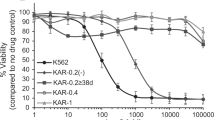Summary
A method for evaluating the regrowth drug resistance in relapsed acute myelogenous leukemia (AMD was developed. Drug sensitivity and proliferation of leukemic cellsin vitro were determined using leukemic cell colony forming unit (CUF-L), MTT drug-sensitive test, percentage of S phase cells in cell cycle (S%), fluorescent index (FI) and drug resistant index (DRI) by detecting intracellular daunorubicin, expression of P-170 glycoprotein by APAAP assay, and abundance of Bcl-XL mRNA by semiquantitative reverse transcription polymerase chain reaction (RT-PCR) methods. First, the correlation between scoring criteria and cell drug resistance and cell proliferation was investigated in newly untreated AML patients. Second, 20 patients with relapsed AML were marked. According to each tested result, its point (s) was scored. The results showed that among the 20 cases of replased AML, 9 were diagnosed as having regrowth drug resistance. It was concluded that the scoring method for regrowth drug resistance was first developed in AML. There was regrowth drug resistance in relapsed AML; clinically circumventing it would be of extreme significance for establishment of new approaches to the treatment in AML.
Similar content being viewed by others
References
Preisler H D, Venugopal P. Regrowth resistance in cancer: why has it been largely ignored. Cell Prolif, 1995, 28:347
Preisler H D, Gropal V. Regrowth drug resistance in leukemia and lymphoma: the need for a new system to classify treatmetn failure and for approaches to treatment. Leuk Res, 1994, 18:149
Bcl-2/1998,27(5):341
DNR 1999,28(1): 31
Raza A, Yasin Z, Gande C. A comparison of rate of DNA synthesis in myeloblasts from peripheral blood and bone marrows of patients with acute nonlymphocytic leukemia. Exp Cell Res, 1988, 176:13
Boise L H, Gonzalez-Garcia M, Postema C Eet al. Bcl-X, a bcl-2-related gene that functions as a dominant regulator of apoptotic cell death. Cell, 1993, 74:597
1998. 214–228
Estey E H. Regrowth resistance. Leuk Res, 1994, 18: 161
1981.174–176
Smyth M J, Krasovskis E, Sutton V Ret al. The drug efflux protein, P-glycoprotein, additionally protects drugresistant tumor cells from multiple forms of caspase-dependent apoptosis. Proc Natl Acad Sci USA, 1998, 95: 7024
Author information
Authors and Affiliations
Additional information
This project was supported by a grant from Science Research Foundation of Health Ministry of China (No. 1996-2-108).
Rights and permissions
About this article
Cite this article
Yan, C., Mingsheng, H., Yudan, W. et al. Investigation on marking method for phenomenon on regrowth drug resistance in relapsed acute myelogenous leukemia. Current Medical Science 21, 286–288 (2001). https://doi.org/10.1007/BF02886558
Received:
Published:
Issue Date:
DOI: https://doi.org/10.1007/BF02886558




